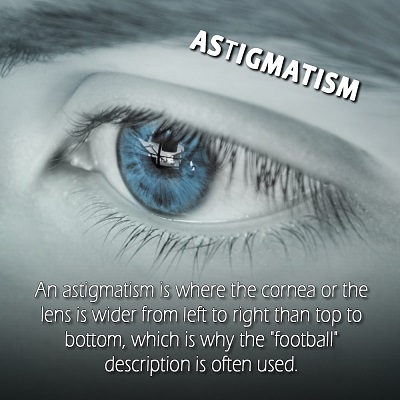Eye Health
 As one of the most common diagnoses given at an annual eye exam, it’s incredible how many people walk away with this new diagnosis and don’t really have a clue what it is, or how they got it.
As one of the most common diagnoses given at an annual eye exam, it’s incredible how many people walk away with this new diagnosis and don’t really have a clue what it is, or how they got it.
Even if your optometrist offered a clinical definition and assured you it’s nothing to worry about, you probably only remember “your eye is shaped like a football” and got stuck on the word astigmatism itself.
The funny thing is, your eye isn’t shaped like a football – it’s the lens. Let’s examine what astigmatism is, common signs and symptoms, how it’s diagnosed and how it’s treated.
Astigmatism Defined
The most basic explanation, and the go-to for optometrists, is the football analogy. This is easy for patients to understand, except they don’t get the whole picture. First, it’s not an eye disease; it’s an irregularity. Continue reading
 If you’ve ever seen an old mirror with a foggy or cloudy blemish, you’ve already got an idea of what a cataract looks like. Cataracts are also commonly described as how it feels when looking at an impressionist painting. Things are a bit blurry, unclear and it’s almost like someone used a blue filter giving everything a yellow tint. They aren’t painful, but they are a nuisance.
If you’ve ever seen an old mirror with a foggy or cloudy blemish, you’ve already got an idea of what a cataract looks like. Cataracts are also commonly described as how it feels when looking at an impressionist painting. Things are a bit blurry, unclear and it’s almost like someone used a blue filter giving everything a yellow tint. They aren’t painful, but they are a nuisance.
A cataract forms when protein deposits build up on the lens of your eye. You can imagine how that might block light from passing through the lens which leads to unclear vision and can cause loss of vision if left untreated.
We tend to blame cataracts on the aging process, but that’s not the only risk factor. Below we will go over the causes, types of cataracts, signs and symptoms, treatment options and prevention tactics for cataracts. Continue reading






